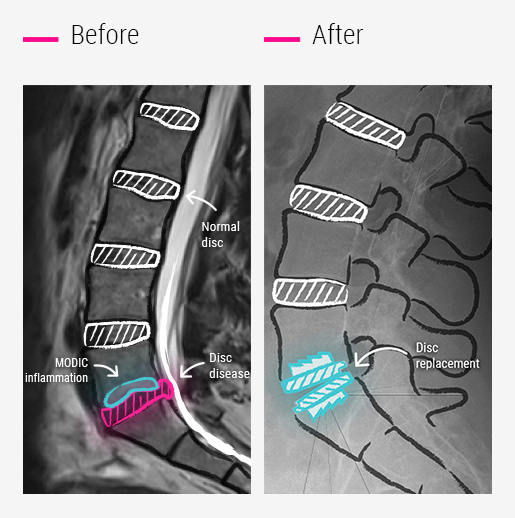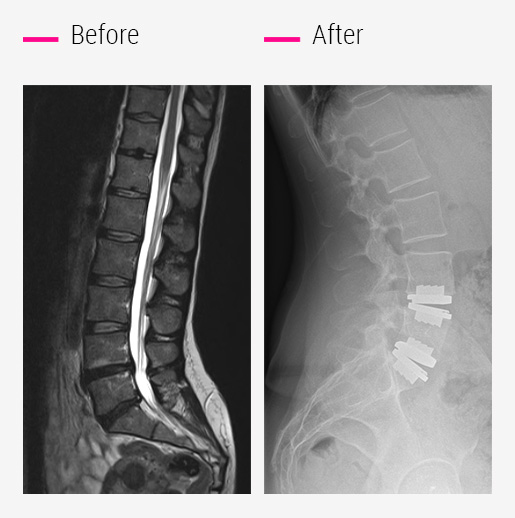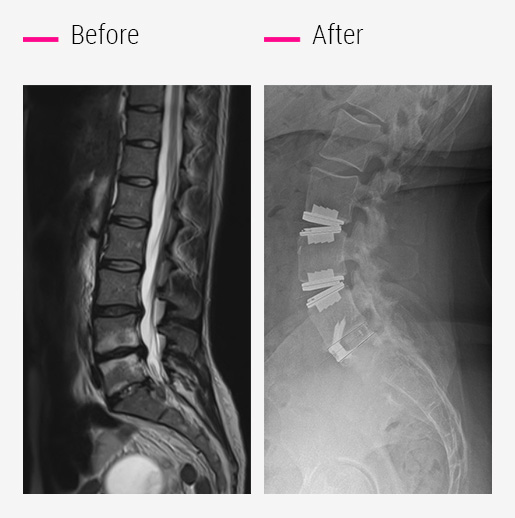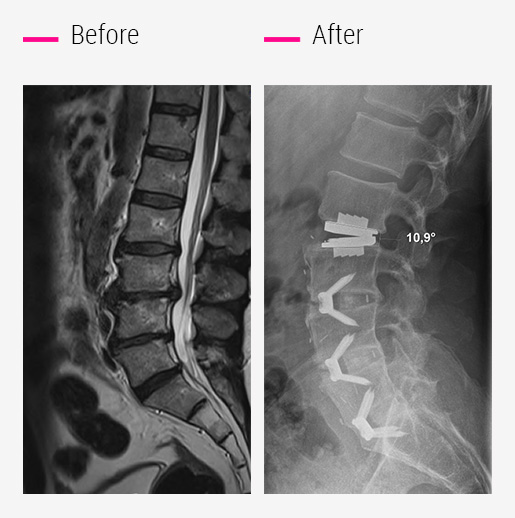DISC REPLACEMENT
An alternative solution to fusion in certain patients with low back pain or recurrent herniated disc.
Relieve pain
Preserve disc mobility and function
Get back to a normal life
The goal after disc replacement is to return to a pain-free life compatible with your professional and sporting activities.
Satisfaction rate 8.6/10
Data from the follow-up questionnaire of 2 143 patients operated on for disc replacemens at the CCV MONTPELLIER since 1999 (source: Institut Montpelliérain du Rachis)
Prodisc®
The world’ s leading disc replacement implant for over 20 years, patented by the CCV Montpellier.
The Prodisc®is a patented surgical disc replacement technology, proven to maintain spinal balance and motion, reduce wear and tear on adjacent discs and accelerate recovery of normal activities.
Chrome-Cobalt alloy plates and PEEK joint implant inlay
Prodisc fixation by means of pins and its porous Titanium coating
Mobility of the Prodisc artificial disc
The Prodisc® adventure
From Dr. Thierry Marnay’s very first patients to global success
Patients implanted with the Prodisc® in 1990 are still being monitored at the CCV Montpellier, making it the most experienced centre in the world for disc replacement surgery.
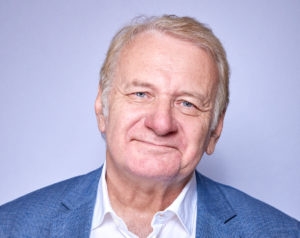
1st Prodisc at the CCV in Montpellier
1st Prodisc in the USA
Dr Thierry Marnay trains all American surgeons
The Prodisc is the most frequently installed implant globally every year for the last 20 years

Having conquered Europe at the end of the 90s, the Prodisc disc replacement then became widely used globally, notably with FDA approval in 2006.
The patients who underwent the first disc replacement in the early 90’s are still being monitored at the CCV Montpellier, and for the moment, no patient has required an implant change.
Consequently, the disc replacement lifespan is considered to be at least 30 years.
Prodisc,® the reference
No other disc replacement system has been as widely studied as the Prodisc®.
Over 25 years of global clinical practice
The most studied disc replacement system in the world1
More than 400 published studies for over 13 000 patients1
More than 125 000 device implantations and a reoperation rate of less than 1%
1 Results Pubmed, Embase, Ovid Medline® from 1988 to 2017
are you a potential candidate for a disc replacement?
While back pain (low back pain) can have various origins (muscular, ligamentous, articular, psychological), severe, chronic, and disabling low back pain in the young individual has as its primary cause lumbar disc disease, which is the progressive degeneration of one or more intervertebral discs.
The main symptoms are as follows:
- Horizontal lumbar pain, increased by exertion, driving and prolonged static sitting or standing
- Morning stiffness and a need to “warm up” to start the day
- Sensation of electric shocks or stabs in the back during certain movements
- Sensation of impending blockages during certain movements, especially when leaning forward
- In the event of a herniated disc in addition to disc disease, onset of sciatic leg pain
What to do about recurrent herniation?

These symptoms sometimes occur in people who have already had surgery for one or more herniated discs. It is important to understand that the purpose of a herniated disc operation is to relieve the compression of the nerve by the disc fragment ejected from its housing, but it does not treat the disc disease responsible for the herniation, which will continue to progress.
- The disc replacement can treat the disc disease and the herniated disc in a single operation.
in the event of damage to multiple discs?
Up to 4 lumbar discs can be replaced in a single surgery.
Depending on the degree of wear, each disc will be replaced with either a mobile or a fixed implant.
THE IMPLANTATION TECHNIQUE
The surgical technique for inserting the implant is minimally invasive. It allows the surgeon to access the spine through a 5 to 8 cm incision through the abdomen in a natural space around the peritoneum sac, which plays a protective role for the abdominal organs. The main blood vessels (aorta, vena cava) will then be mobilized, enabling complete visualisation of the disc.
The intestines can return to their natural position by simply removing the retractors once the implant is in place. The only element severed throughout the entire approach is the abdominal muscle sheath, which will be sutured at the end of the procedure.
Why operate through the abdomen
The disc is in the front part of the spine, while the nerves and spinal cord pass through a canal at the back of the spine. By accessing the disc through the abdomen, the disc replacement can be placed without disturbing the nerve roots; consequently, there is less risk of damaging the spinal nerves than with the more traditional techniques of approaching the spine through the back (posterior approach).
POST-OPERATIVE FOLLOW-UP
Thanks to the minimally invasive technique and the Enhanced Recovery After Surgery (ERAS) procedure implemented at the CCV Montpellier, assisted by the physiotherapist the patient can move around after surgery on the afternoon of the operation. The rehabilitation programme for simple daily activities is explained and then put into practice with the physiotherapy team on the day following the operation. Return home is usually on the 2nd day after the operation.
CONVALESCENCE
The average recovery time is 6 to 8 weeks. Rest and walking are recommended during the first 2 to 4 weeks, then light daily activities, are resumed very gradually. More physical activities and endurance sports can be started from the 8th week. Exercise capacity will gradually increase throughout the year following surgery. In the long term, there is no contraindication to any sport, or any specific activity in patients with a disc replacement.
RESUMING ACTIVITIES
The goal after disc replacement is a life free of back pain. Nevertheless, not all patients will achieve this goal and the persistence of either low back pain or sciatica, often at a reduced level than before surgery, is possible.
Feeling pain is the only limitation to activity, whether during recovery or afterwards. Listening to the body will always be the best way of living.
In this way, thanks to the disc replacement, patients who no longer have pain will not be restricted in their sporting activities (golf, tennis, football, skiing, kitesurfing, etc.) or in their professional activities (office work, driving, construction, agriculture, etc.).
DISC REPLACEMENT SURGERY KEY POINTS
- Indication: painful lumbar disc disease resistant to medical treatment for more than 6 to 12 months, certain forms of recurrent herniated discs.
My E-Diagnosis
Wherever you are, access the services of an expert in spinal surgery
Request a free medical opinion, video teleconsultation, organise a customised medical stay… our e-medicine service offers you a whole range of services designed to give you access to a team of spinal surgery experts.
Number of discs that can be treated
Abdominal scar, between the navel and the pubis
No restraint (no belt or corset)
Duration of surgery
Average length of hospital stay
Average recovery time
weeks
Minimum duration of absence from work
Period before starting back driving
Period before resuming sports activities
Flying home after surgery
Duration of evolution until the final result of the surgery

 Tele-consultation
Tele-consultation
 Make an appointment
Make an appointment
